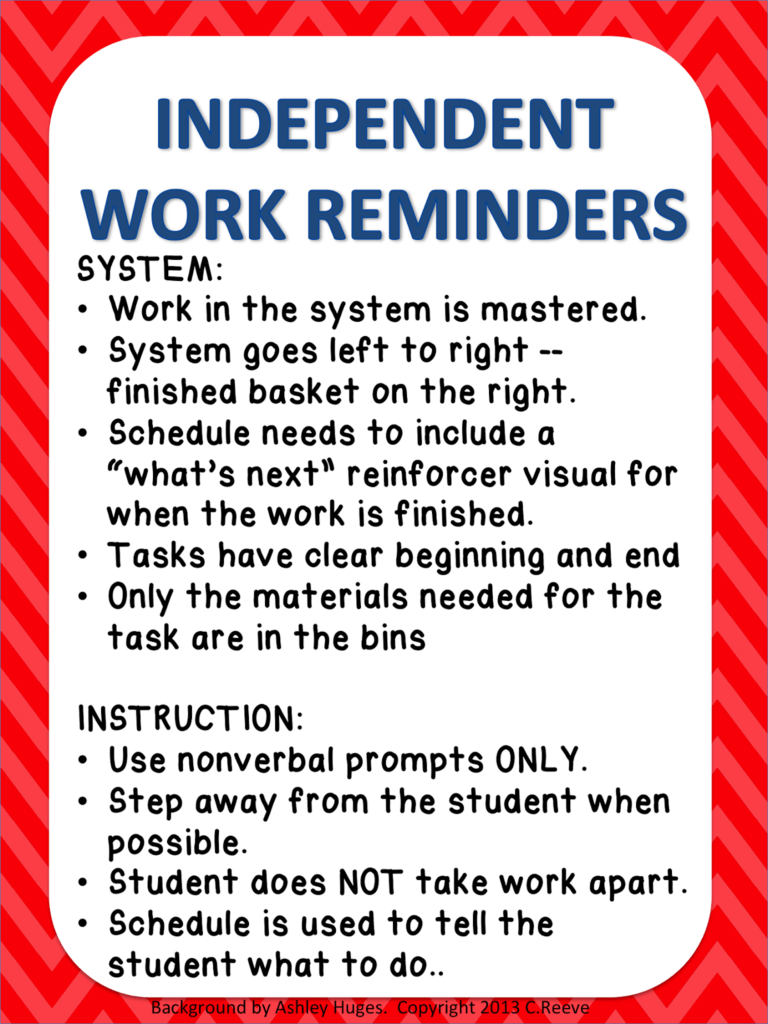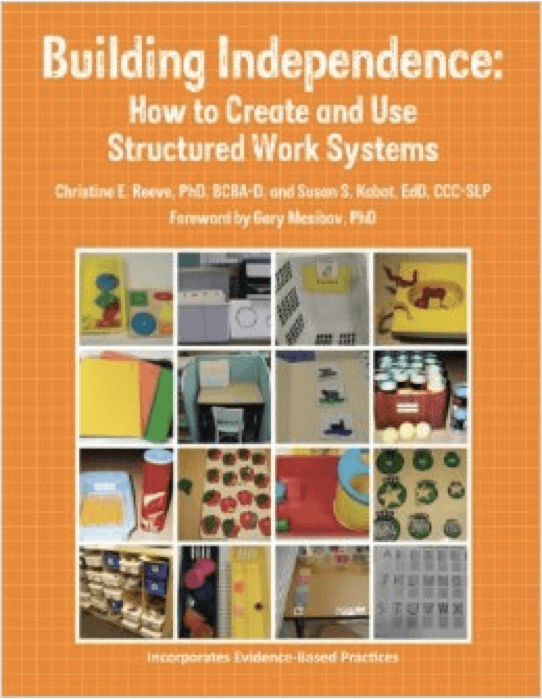Having talked about the additions to the evidence-based practices in the new report, I want to talk about the one practice that was dropped. For earlier posts in the series, click HERE.
You all know by now that I love Structured Work Systems (SWS) (also called independent work systems). I love them so much I wrote about a book about them in fact. If you aren’t familiar with them, you can read more about them HERE. In the 2011 report from the National Professional Development Center, SWS were considered an evidence-based practice. Yet, in the 2014 report they were the only previous EBP that was dropped. So what gives? Did somebody show they weren’t effective? Does that mean we should stop using them? How could they be effective and then not effective? The answers are-no, they haven’t been shown to be not effective and no we shouldn’t stop using them. And the answer to the last question…let me explain.
SWS still have evidence to support them. The change came about because the criteria that the National Professional Development Center made the criteria more strict for inclusion in EBPs in order to better align with other agencies who review EBPs in education. The evidence from 2011 and 2014 is essentially the same….and all the same reasons for using them still exist. However, the way the studies were evaluated changed and SWS no longer met that criteria.
So, what does the research say about SWS?
First, the National Professional Development Center talks about them in the report as one of the emerging practices (I’ll talk about this list later this week) that has some evidence to support them. Previously there were 5 studies that were cited as supporting SWS in the 2011 report. Of those 5, all but 1 no longer met the experimental rigor required by the new criteria, so they were not included. In between 2011 and 2014, however, 2 new studies were added to the literature showing the work systems were effective for individuals on the spectrum. However, all 3 of the existing studies were single-subject research and the new guidelines required that there be at least 5 single subject research studies to be qualified as an EBP. So, in short, there is evidence to support them, but the evidence, at the moment, doesn’t meet the new requirements for being an EBP.
Here’s a brief summary of what the existing research tells us. Hume and Odom (2007) found that the use of work systems in the classroom resulted in increases in on-task behavior, reduction of teacher prompts and increases in the number of activities that were completed. They followed up one month later and found that results maintained as well. Their participants included a 20-year-old, a 6 year-old and a 7 year old, all with diagnoses of autism and severe disabilities.
Bennet, Reichow, and Wolery (2011) found that preschool children (2 of the 3 had autism) completed more tasks, were more engaged in the work or play activities, and completed the activities more quickly and accurately when they used a structured work system (and were taught to use it) than when they didn’t use the work system. Interestingly they also found that the participants had less stereotypical behavior and fewer escape-function challenging behaviors when using the system than when they didn’t.
Mavropoulou, Papadopoulou, and Kakana (2011) found more mixed results in working with children with autism, both 7 years old, who were being educated primarily in a self-contained classroom. Their study focused only on teaching play types of behaviors. One participant showed more independence with the use of the system while the other showed a trend of more independence but the differences were not significant. Both participants were more accurate in their task completion but again one participant met statistical significance for this while the other did not. I also have to note that the teachers in the study were not given instruction in the use of prompts in the presentation of the tasks and their prompting stayed fairly stable when the work was organized in a work system and when it was not. Further research needs to be done looking at this element (i.e., how we prompt during the work system, is providing only nonverbal prompts and fading prompts an optimal method) as well as which other elements in the system might be important contributors to independence. With that said, it is useful to note that this study may indicate that work systems may be effective for some individuals and not for others, which is true of most of our interventions.
Putting the Research to PracticeSo, what does this very long post mean for what we do in the classroom? Here are what I see as the takeaway points.
1. SWS can increase independence
For some individuals at least, SWS can increase independence, accuracy and fluency in completing tasks, and decrease some challenging behaviors. Consequently they are worthwhile to use in the classroom to practice skills to maintain them.
2. We need individual data
Regardless of the evidence base found for any intervention, that intervention may work well for some students and not for others. Consequently, when we use them, we must make an individual decision about using an intervention based on the performance data of the student.
3. Implementation fidelity is a key element
 No matter how much evidence there is to support any intervention, if we don’t implement it with fidelity–the way it was intended and studied, the results are not likely to be similar to the research. Making sure that all the staff is trained to implement the interventions as they were studied is an important component. Then doing periodic checks for what I call “program slippage” is important. Program slippage occurs because it’s easy to drift away from the standards of practice and it’s hard to recognize in yourself that you are doing so. To help this, I wanted to give you a freebie I had on the blog a while back but I think may be useful. These are reminders for staff of the steps and importance of elements in implementing work systems. I have used similar ones in a variety of settings–remember visual supports are not just for our kids. You can access the freebie HERE. You can also find an implementation checklist for all the evidence-based practices in the 2011 report, including SWS, under the evidence based practice section for each intervention HERE at the NPD site.
No matter how much evidence there is to support any intervention, if we don’t implement it with fidelity–the way it was intended and studied, the results are not likely to be similar to the research. Making sure that all the staff is trained to implement the interventions as they were studied is an important component. Then doing periodic checks for what I call “program slippage” is important. Program slippage occurs because it’s easy to drift away from the standards of practice and it’s hard to recognize in yourself that you are doing so. To help this, I wanted to give you a freebie I had on the blog a while back but I think may be useful. These are reminders for staff of the steps and importance of elements in implementing work systems. I have used similar ones in a variety of settings–remember visual supports are not just for our kids. You can access the freebie HERE. You can also find an implementation checklist for all the evidence-based practices in the 2011 report, including SWS, under the evidence based practice section for each intervention HERE at the NPD site.
Hopefully this has given you some things to think about with Structured Work Systems. The references referred to are below. If you are interested in gaining more information about them, you can check out our book (affiliate link provided) and the structured work system starter kits from my TPT store.
Until next time,
References:












![Independent Work-3 Ways It can Become Your Best Classroom Management Tool [A sorting task in a shoebox to sort nouns from verbs on popsicle sticks into plastic cups]](https://autismclassroomresources.com/wp-content/uploads/2023/06/BLOG-22208-3-Ways-Task-Boxes-and-IW-Help-Classroom-Management-2-768x644.jpg)
